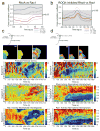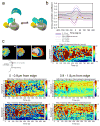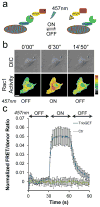Direct multiplex imaging and optogenetics of Rho GTPases enabled by near-infrared FRET
- PMID: 29686359
- PMCID: PMC5964015
- DOI: 10.1038/s41589-018-0044-1
Direct multiplex imaging and optogenetics of Rho GTPases enabled by near-infrared FRET
Erratum in
-
Publisher Correction: Direct multiplex imaging and optogenetics of Rho GTPases enabled by near-infrared FRET.Nat Chem Biol. 2018 Sep;14(9):902. doi: 10.1038/s41589-018-0070-z. Nat Chem Biol. 2018. PMID: 29728601
Abstract
Direct visualization and light control of several cellular processes is a challenge, owing to the spectral overlap of available genetically encoded probes. Here we report the most red-shifted monomeric near-infrared (NIR) fluorescent protein, miRFP720, and the fully NIR Förster resonance energy transfer (FRET) pair miRFP670-miRFP720, which together enabled design of biosensors compatible with CFP-YFP imaging and blue-green optogenetic tools. We developed a NIR biosensor for Rac1 GTPase and demonstrated its use in multiplexed imaging and light control of Rho GTPase signaling pathways. Specifically, we combined the Rac1 biosensor with CFP-YFP FRET biosensors for RhoA and for Rac1-GDI binding, and concurrently used the LOV-TRAP tool for upstream Rac1 activation. We directly observed and quantified antagonism between RhoA and Rac1 dependent on the RhoA-downstream effector ROCK; showed that Rac1 activity and GDI binding closely depend on the spatiotemporal coordination between these two molecules; and simultaneously observed Rac1 activity during optogenetic manipulation of Rac1.
Conflict of interest statement
Figures






References
Publication types
MeSH terms
Substances
Grants and funding
LinkOut - more resources
Full Text Sources
Other Literature Sources
Research Materials
Miscellaneous

